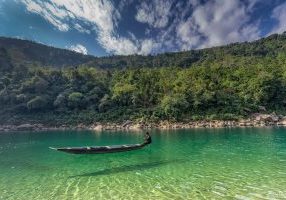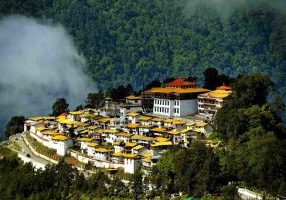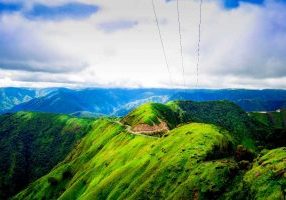Assam is dominated by the mighty River Brahmaputra, and its vast, lush valley sandwiched between the Himalayan foothills to the north and the Meghalayan hills and plateau to the south. An attractive state carpeted by plantations, forests and paddy fields, Assam is one of India’s few oil regions, and produces around sixty percent of the nation’s tea. However, the industry is not as profitable as it once was, and for the marginalized baganiyas (tea workers), mainly adivasis – tribal people brought in from central India by the British to work as indentured labourers on the plantations – depressingly little has changed since colonial times.
PLACES TO VISIT IN THIS REGION
Social divisions and ethnic strife have lead to long-term instability in the state. The separatist group United Liberation Front of Asom (ULFA) began an armed struggle for independence in 1985, and in the early 1990s Assamese nationalism sparked opposition from Bodos, Cachars and other ethnic minorities. Bangladeshi migration into Assam has been a bone of contention for indigenous Assamese, resulting in the deadly clashes of 2012 between migrant Bangladeshis and Bodos that left several dead in the western districts of the state.
Despite the seemingly insurmountable ethnic tensions, occasional violence reported in the press, bandhs and political in-fighting, the situation has vastly improved, as has the infrastructure. More and more visitors are enjoying the delights of the local wildlife and tea plantations, as tourists are rarely embroiled in the strife that underlies the social fabric of Assam.
Travel advice
Although roads in the Assam valley are well-maintained along the Brahmaputra up to Pasighat and Roing, and there is a good stretch from Tezpur to Tawang, elsewhere – especially in the hills of Nagaland and the interior of Arunachal Pradesh – roads are generally in a terrible state and journeys can prove tedious and painfully slow. If arranging car rental, ensure you rent a large vehicle such as a Sumo or Bolero for the mountains of Arunachal Pradesh.
Trains along the valley from Guwahati to Upper Assam and Dimapur are reasonable, and there is a rail-link to Naharlagun in central Arunachal. At the time of research, the railway was being extended from Dibrugarh to Pasighat, and should be operational by the time you read this.
Flights are the most convenient mode of travel, with major airports at Guwahati, Agartala (Tripura), Aizawl (Mizoram), Dibrugarh, Silchar, Dimapur and Imphal.
Some of the ferries along the Brahmaputra are useful, especially those connecting Majuli Island with the north and south shores of the Brahmaputra, while upmarket cruises provide a languid and leisurely way of discovering the river and surrounding areas.
Money-changing facilities most towns these days have banks and ATMs, but you should travel with enough cash if you plan of striking off in the countryside.
Guwahati
The state capital, Guwahati (or Gauhati), lies on the banks of the mighty Brahmaputra. Although some of the old town still retains its character, Guwahati is a rapidly expanding city of shopping malls. As the main gateway to the region you may well need to stay here briefly. Guwahati’s main attractions are the Kamakhya, Navagraha and Umananda temples, while northwest of the city are the silk village of Sualkuchi, the pilgrimage site of Hajo and Manas National Park.
As the primary hub for the region’s lucrative tea industry, Guwahati’s Assam Tea Auction Centre at Dispur is the largest trade centre in the world for the CTC (crush, tear and curl) tea so characteristic of Assam. Elsewhere, the bustling markets of Paltan Bazaar, Pan Bazaar and Fancy Bazaar, Guwahati’s main shopping areas, are bunched in the centre on either side of the railway, with the older residential areas north of the tracks spread along the riverside. Assamese silk, wooden rhinos and other crafts are sold at several shops on GNB Road.
Kaziranga National Park
A World Heritage Site covering 430 square kilometres on the southern bank of the Brahmaputra, Kaziranga National Park, 217km east of Guwahati, occupies a vast valley floor against a backdrop of the Karbi Anglong Hills. Its rivulets, shallow lakes and semi-evergreen forested highlands blend into marshes and flood plains covered with tall elephant grass teeming with deer and wild buffalo. However, the big draw, is the park’s famous yet highly endangered one-horned rhinos, best observed from the back of an elephant first thing on a winter’s morning. Tiger sightings are relatively rare, despite the park’s official claim to have the highest density of tigers of any park in the world.
Jeeps take you deeper into the forest than elephants, but cannot get nearly as close to the rhinos and buffalo. The abundant birdlife includes egrets, herons, storks, fish eagles, kingfishers and a grey pelican colony.
Upper Assam
Around 310km northeast upriver from Guwahati, Jorhat has an airport and road connections to Kaziranga, Nagaland, Guwahati, Kolkata and northern Arunachal Pradesh. The city is noteworthy as a transport hub alone – you will almost certainly have to wade through Jorhat at some point on a trip to the Northeast.
The unique Vaishnavite culture of Majuli, reputedly the world’s largest river island, and Sibsagar, former capital of the Ahoms, are also close by. Further north, Dibrugarh is full of tea plantations to explore and is the gateway to northern Nagaland and eastern Arunachal Pradesh. There is good birdwatching at Dibru-Saikhowa National Park, while Digboi has an interesting oil museum and war memorial.
Majuli
Within striking distance of Jorhat, Majuli is often described as one of the largest inhabited river islands in the world, but erosion in recent years is threatening its claim and, indeed in the long run, its future. Regardless of its precise status, Majuli is a fascinating place and a true gem of the Northeast, largely because of its unique Vaishnavite satras (Hindu monasteries), though it is also a haven for birdwatchers. There are 22 satras – institutions that contain elements of a temple, monastery, school and centre for the arts – on Majuli: each consists of a prayer hall (namghar) surrounded by living quarters for devotees, and ghats for bathing. Music, song and dance are essential elements of the devotional life of the satras and you may be lucky enough to catch one of the performances that are sometimes arranged for large parties of visitors.




